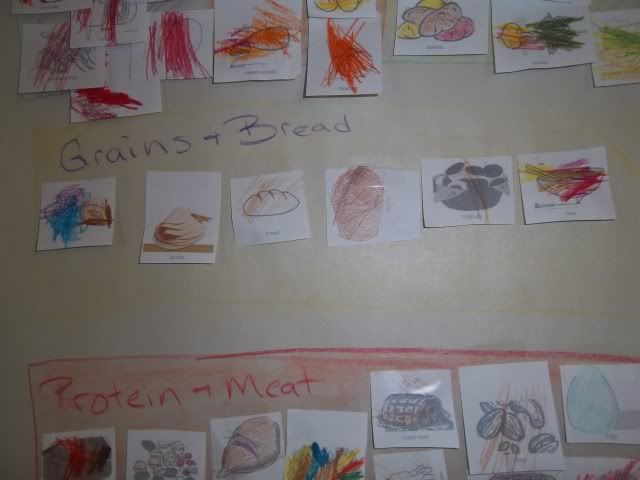Also, we let the kids pick their breakfast, lunch and snacks from a list of choices. We truly believe in giving them as much freedom as possible, but we also believe in educating them about the choices they are making. It seems silly to us to not inform them that the fire is hot and then to let them play in the room with a fire. The same goes for food - we want them to understand the value and danger of food while letting them have a large say in what they eat.
So, I began looking for some information about teaching preschoolers about nutrition. But none of the resources I found really worked for our family. To start with, my son has some extensive food sensitivities which means that he can't eat an entire food group from the traditional food pyramid. Also, I don't believe that fats are the bad guys that they are made out to be, and we make sure to get plenty of them every day - so lumping them in with sweets definitely doesn't work for us.
I began to think over what I believe to be true about nutrition, and to put together a lesson for the children that would reflect those beliefs - and would also be age appropriate for them. This is what I came up with!
I started with a large sheet of newsprint. I wrote across the top "Healthy Eating" - not that they can read it! Then, I drew a large rectangle, all of the way across the top of the paper. I asked what kind of foods we need to eat a lot of. My daughter answered quickly, "Vegetables!" I asked what else was like vegetables and she promptly responded, "Fruits!" So we labelled that top box "Fruits and Vegetables". We broke it into 5 different, equally sized squares and colored each square in a rainbow color.
Next, we drew another rectangle, not quite so large as the first, and labelled it "Grains and Breads". Next we added "Proteins and Meats" in a box about the same size as the grains box. Across the bottom was a square called "Calcium", a rectangle called "Oils and Fats" and a small rectangle labelled "Sweets and Treats".
We cut the label off of our rice milk jug and put it in the calcium square (just to be clear, we used an empty, washed jug for this). We will add an almond milk label when we have an empty jug too. Then, we ran off to the computer and Google Images where we looked up pictures of MANY of our favorite foods! I let the kids help to come up with ideas for the foods, and we looked for black and white pictures so that we could color them in. When we had most of our favorites, we printed up the pictures in thumbnail size. Then we had a good time coloring them in. After everything was colored in, we got out the clear tape and taped each food onto the chart where it belonged. The fruits and veggies we separated by color to show that each color had a value.
It was a very interesting lesson for the kids, and a great visual representation for them of the food groups that we actually eat, along with how much of each item we should be eating. I don't necessarily believe in daily servings so much as I believe in overall balance, and I think that the varying size squares really represent that well. I was also lovingly impressed with the foods the children chose. While they forgot some of the basics (melons, carrots), they remembered things like turnips, and mango.


Throughout the short term future, we will talk about what we are eating, and where it belongs on the chart, whether it is something we should eat lots of or just a little bit, why we should choose organic options, how each item on the chart contributes something different to our bodies, and why it is important to eat a balance of foods instead of just a lot of mayonnaise - not that anyone at our house has a problem with that, or anything!




absolutely beautiful, Kellie.
ReplyDeleteThank you, Kelly! :D
ReplyDelete